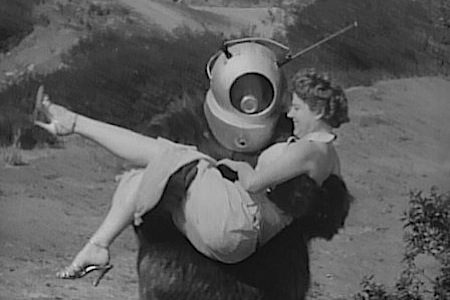The Wonder of the Feedback Loop: Art, Sci-Fi, and Real Life
Throughout the history of modern times, the art and, well—science—of science fiction have frightened, entertained, and inspired us. While the genre is hard to define because there are literally no limits, sci-fi imagines possible realities for the human (and other!) species based on science and physical laws, both real and speculative.
Space, time, and light travel, parallel universes, ETs, androids, robots and mutants, other worlds and black holes—we’ve experienced it all through the imaginations of sci-fi writers and directors. Sci-fi plots frequently fall into one of two scenarios: dystopian futures of despair or utopian futures of hope and bliss. Often encompassing politics and culture, sci-fi creates a crossover between the sciences and the humanities.
Invasion of The Saucer-Men movie poster 1957
Jules Verne wrote Paris in the Twentieth Century, in 1863. Set in the distant 1960s, he predicted automobiles, elevated railways, fax machines, even ATMs. His publisher considered the work too dark; it was left unpublished until 1994.
Although the term “sci-fi” was not coined until the 1920s, some consider Mary Wollstonecraft Shelley, who penned Frankenstein, the mother of the genre. And the Victorian “scientific romance” era (inspiration for today’s Steampunk aesthetic) gave us the works of Verne (including the space balloon travel he envisioned in From the Earth to the Moon), H.G. Wells’ The Time Machine and War of the Worlds, Edgar Rice Burroughs’ A Princess of Mars, Sir Arthur Conan Doyle’s The Lost World, and countless other novels.
The Golden Age of modern science fiction emerged in the 1920s with the publication of the popular Amazing Stories Magazine and the founding of the Science Fiction League—the first vestiges of sci-fi fandom and mass acceptance. The 1950s brought us the atomic bomb and an agglomeration of cheaply-made, unsophisticated, yet highly-entertaining B-movies with titles like Plan 9 from Outer Space, Creature From the Black Lagoon, Teenagers From Outer Space and Robot Monster, featuring cheesy stagecraft that is more laughable than terrifying, particularly by today’s standards. In fact, some point to the juvenile nature of the genre overall—people tend to discover and get hooked on sci-fi around the time of adolescence, when wonder and awe still feel natural to us.
Robot Monster movie poster.
Recommended Reading:
Rolling Stone Magazine rates the best sci-fi moves of the 21st Century
Paste Magazine: The Best B movies of all time
Five Facts About Futurist Father of Science Fiction, Jules Verne
Plan 9 From Outer Space Trailer
And for some real, out-of-this-world science (even more wondrous than fiction), see NASA’s Hubble Space Telescope images
Not of This Earth movie poster. 1957
The miracle of sci-fi is that it has become its own feedback loop: a self-creating reality that dramatically out-pictures the power of art as tangible technologies. The artist dreams of an imagined future and creates a work of literature, a film, a television series, or even a terrible B-movie.
The audience who’s attracted to these works of exploratory thinking often have brilliant scientific minds—engineers and scientists with the ability to actually invent—the means through which fiction comes to fruition as practical, operational technology that advances our civilization.
“That’s the beauty of art, It can take you to new possibilities,” says Wonderbound Artistic Director, Garrett Ammon. “Look at some of the technology we now take for granted, like the communicators and touch screens from early Star Trek.”
Gene Roddenberry’s groundbreaking original Star Trek series, which ran on television from 1966-69, inspired a new generation of sci-fi fans with its exploration of both space travel and social issues. Fahrenheit 451 and 2001: A Space Odyssey moved sci-fi beyond the B-movies into a more serious realm, and advances in special effects resulted in blockbuster motion pictures like Star Wars, Close Encounters of the Third Kind, ET: The Extraterrestrial, Blade Runner, andThe Terminator, Alien, and Jurassic Park series.
Today, our technologies like computer-generated imagery, 360 degree video, and artificial intelligence evolve faster than we can keep up, continually blurring the lines between fantasy and reality and changing the way we understand and experience science fiction.
As art continues to become reality through the magic and wonder of science fiction, the National Science Foundation tells us that those who read and watch sci-fi are more likely to believe that extraterrestrial contact is both possible and desirable; these sci-fi aficionados strongly support space programs and exploration.
Many are inspired through their love of sci-fi to become real life engineers and scientists. And the Hieroglyph Project at Arizona State University is committed to leveraging science fiction to make positive change in the real world.
Even some visionary musicians and choreographers, it seems, are inspired by the imagined futures of science fiction to create works of art.




